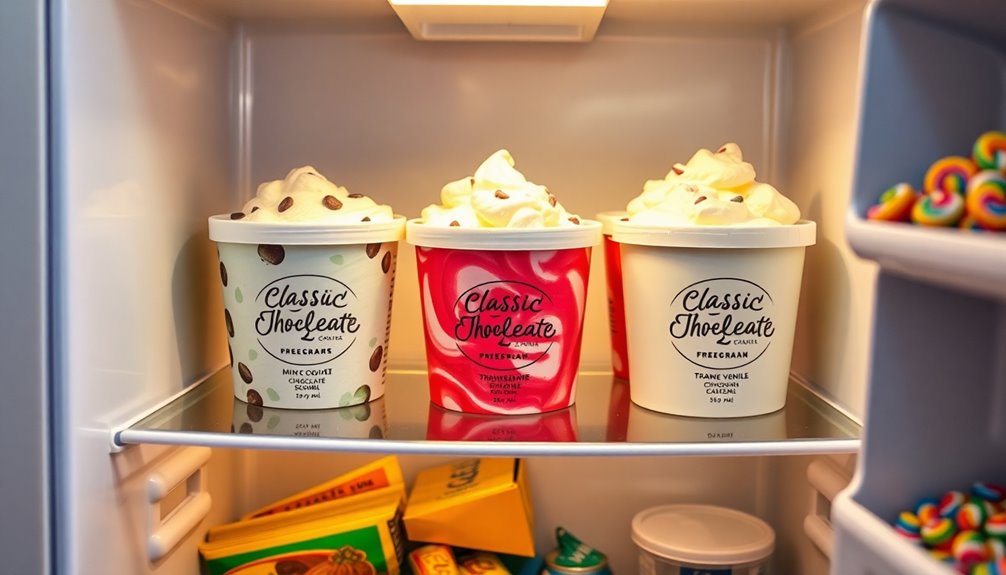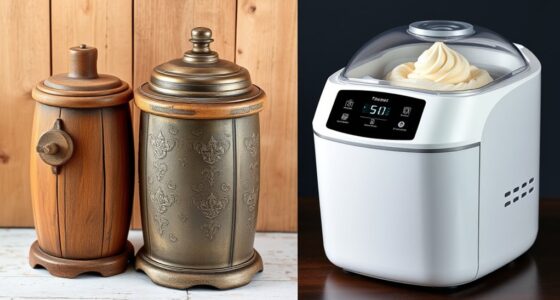Storing ice cream in a dorm fridge can be tricky due to temperature limitations. Most mini-fridges don’t maintain the ideal freezing temperature of 0°F (-18°C). To keep your ice cream frozen, choose a model with a compressor system and a separate freezer compartment. Set the freezer to its coldest setting and use airtight containers to prevent freezer burn. For the best results, monitor your freezer’s temperature and adjust your storage practices as needed to keep your treats perfectly frozen. There’s more valuable info ahead.
Key Takeaways
- Set the dorm fridge’s freezer to 0°F (-18°C) or lower to ensure ice cream remains frozen properly.
- Use a thermometer to monitor the actual freezer temperature for consistent cold storage.
- Store ice cream in airtight containers to prevent freezer burn and maintain texture.
- Limit door openings to avoid temperature fluctuations that can affect ice cream quality.
- Consider a mini-fridge with a compressor cooling system for better temperature control and storage efficiency.
Understanding the Cooling Limitations of Mini-Fridges
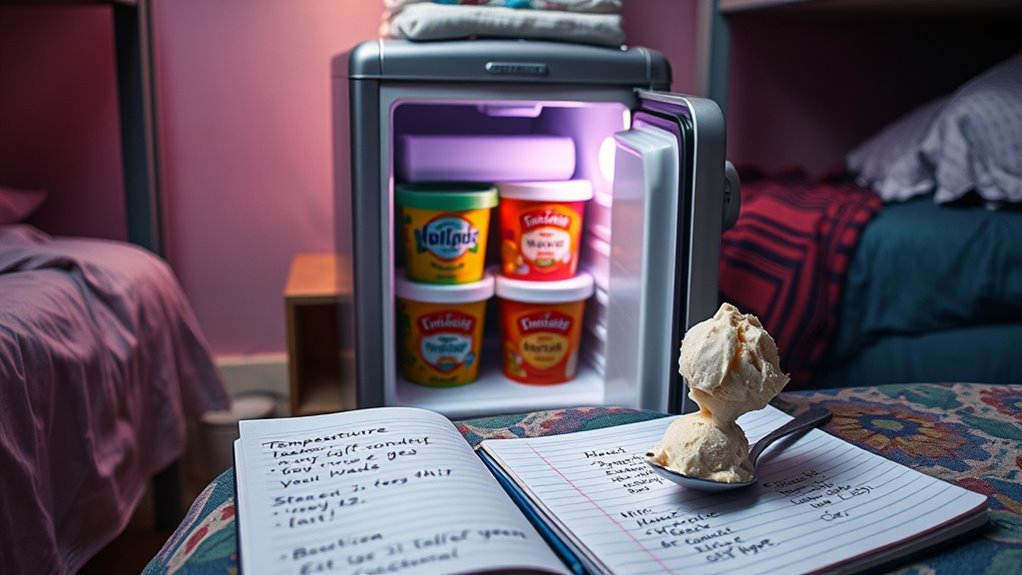
When you rely on a mini-fridge to store your ice cream, you might run into some cooling limitations that can affect its quality.
Mini-fridges often maintain temperatures above 0°F (-18°C), which isn’t low enough to keep your ice cream properly frozen. Many dorm fridges use thermoelectric cooling systems that struggle in high humidity, failing to reach the necessary low temperatures for solid consistency.
Mini-fridges often can’t maintain the necessary low temperatures, leading to poor ice cream storage and inconsistent texture.
Their small freezer compartments usually only produce ice cubes instead of maintaining ice cream in a frozen state. Plus, regular manual defrosting is required to prevent frost buildup, which can further diminish cooling efficiency.
Due to these limitations, mini-fridges aren’t ideal for long-term ice cream storage, leading to inconsistent texture and melting.
Choosing the Right Mini-Fridge for Ice Cream Storage

Selecting the right mini-fridge for ice cream storage can make a significant difference in maintaining your favorite treat’s quality.
Look for a mini fridge with at least a 4.3 cu ft capacity to fit a half-gallon of ice cream comfortably. Choose models with a compressor cooling system, as they offer better temperature control and freezing capabilities than thermoelectric options.
It’s essential to have a separate freezer compartment that reaches 0°F (-18°C) or lower, ensuring your ice cream stays solid. Opt for a mini fridge with adjustable temperature settings, allowing you to set it to the coldest for ideal preservation.
If you’re a true ice cream enthusiast, consider investing in a dedicated ice cream freezer for the best results.
Optimal Temperature Settings for Freezing Ice Cream
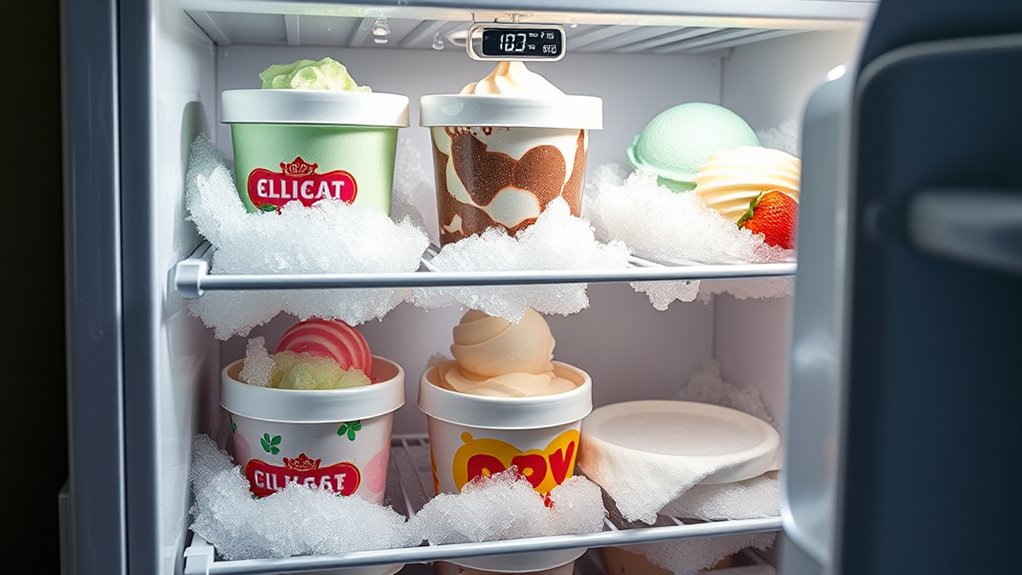
To keep your ice cream at its best, you need to set your dorm fridge’s freezer to 0°F (-18°C) or lower.
Adjust the dial to the coldest setting and check the temperature with a thermometer to guarantee it stays consistent.
A full freezer also helps maintain the right temperature, so fill it up whenever you can!
Ideal Freezing Temperature Range
The ideal freezing temperature for ice cream is 0°F (-18°C) or lower, ensuring it retains that perfect creamy texture without turning soupy or icy.
To achieve this in a dorm fridge, follow these tips for your freezer compartment:
- Set your freezer to the coldest setting for best ice cream storage.
- Use a thermometer to monitor the actual temperature, keeping it within the ideal range.
- Avoid frequent opening of the freezer, as this causes temperature fluctuations that can compromise texture.
- Keep your freezer full; a packed freezer helps maintain temperature stability, essential for preserving your ice cream.
Dial Settings for Freezing
Achieving the right freezing temperature for your ice cream starts with proper dial settings on your dorm fridge. Set the dial to its highest number, which guarantees the coldest temperature, ideally below 0°F (-18°C). This adjustment helps keep ice cream frozen and prevents it from becoming too soft.
Remember to turn the dial clockwise to lower temperatures effectively. To guarantee your ice cream stays perfectly frozen, check the freezer temperature regularly with a thermometer. Avoid using the defrost button often, as it can disrupt freezing conditions.
Also, don’t overload the freezer; proper airflow is essential for maintaining consistent temperatures. Following these tips will help you enjoy delicious ice cream whenever you crave it!
Monitoring Temperature Consistency
While it might be tempting to rely solely on the fridge settings, consistently monitoring the temperature is crucial for keeping your ice cream at its best.
The ideal temperature for storing ice cream is 0°F (-18°C) or lower. Use a thermometer to verify the freezer maintains that temperature, as fluctuations can result in soft, unappetizing ice cream.
Here are some tips to help you keep things frosty:
- Adjust the fridge dial clockwise for colder settings.
- Maintain a full freezer to improve temperature retention.
- Avoid using the defrost button frequently, as it disrupts operation.
- Regularly check the temperature to catch any inconsistencies early.
Best Storage Practices for Ice Cream in Mini-Fridges
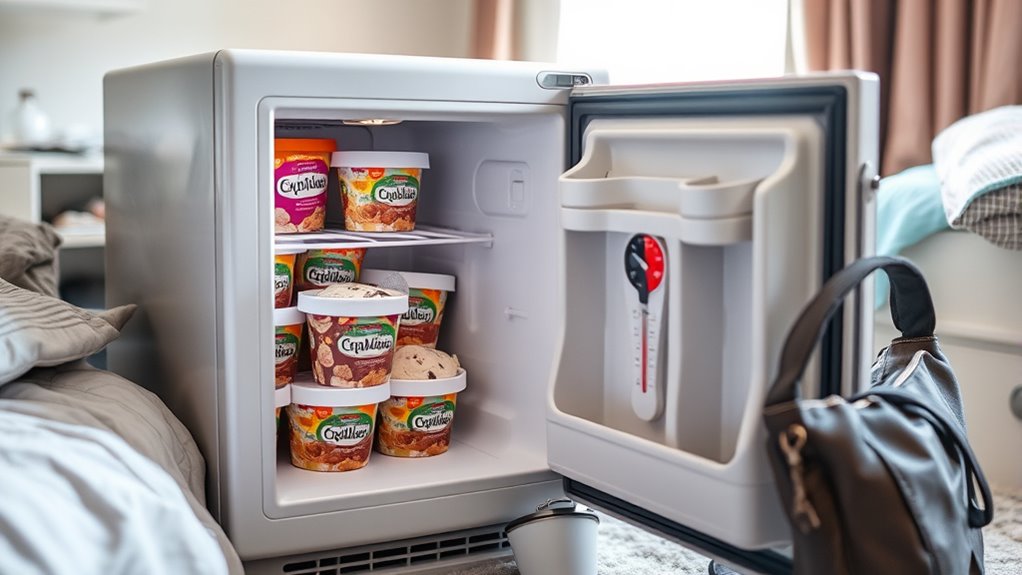
To keep your ice cream in top shape, you need to follow some best storage practices in your mini-fridge.
Start by ensuring the temperature is ideal, then choose the right containers to prevent freezer burn.
Finally, manage your space wisely to keep your frozen treats at their best.
Optimal Temperature Settings
When it comes to storing ice cream in a dorm fridge, setting the ideal temperature is crucial for preserving its creamy texture and flavor. Aim for 0°F (-18°C) or lower to keep your ice cream at its best.
Here’s how to guarantee you’re able to keep it perfect:
- Set the freezer compartment to its coldest setting.
- Use a thermometer to monitor the temperature consistently.
- Minimize door openings to prevent warm air from entering.
- Store ice cream in airtight containers to avoid freezer burn.
Container Selection Tips
Choosing the right containers is essential for keeping your ice cream in top shape inside a mini-fridge. Use airtight containers to minimize air exposure, which helps prevent ice crystal formation and maintains your ice cream’s creamy texture.
Avoid storing ice cream in its original cardboard container for long-term storage; it doesn’t seal well against air. To enhance preservation, keep your containers at the back of the freezer compartment, where temperatures remain stable.
Consider labeling your containers with purchase dates so you can track freshness and consume older stock first. Finally, organize your mini-fridge to minimize door openings, reducing warm air intrusion and ensuring consistent freezing temperatures for your delicious treats.
Space Management Techniques
Effective space management is key to storing ice cream in a mini-fridge without sacrificing quality. By implementing smart space management techniques, you can guarantee your ice cream stays deliciously frozen.
Here are some best practices:
- Use airtight containers to minimize air exposure and reduce freezer burn.
- Place containers at the back of the freezer for stable temperatures, keeping them solid.
- Avoid overloading your mini-fridge to maintain proper airflow and consistent freezing.
- Utilize vertical space by stacking containers, guaranteeing they’re easily accessible to limit door openings.
These tips are designed to keep your ice cream fresh and tasty, so check it regularly for consistency.
A little effort goes a long way in enjoying your frozen treats!
Preventing Temperature Fluctuations in Your Fridge

To keep your ice cream firm and delicious, it’s vital to prevent temperature fluctuations in your dorm fridge.
Start by setting the freezer compartment to its lowest temperature, ideally around 0°F (-18°C). A well-filled freezer helps maintain a low temperature, as it retains cold better than an empty one.
Limit how often you open the door; each time it swings open, warm air rushes in, raising the internal temperature.
For best storage, place your ice cream containers at the back of the freezer, where temperatures are more stable.
Finally, regularly check the freezer temperature with a thermometer to verify it stays at or below the ideal freezing point for effective ice cream storage.
Strategic Placement of Ice Cream in the Freezer

While you might be tempted to shove ice cream anywhere in the freezer, strategically placing it can make a big difference in maintaining its texture.
Strategic placement of ice cream in the freezer is key to preserving its perfect texture.
Here’s how to optimize your ice cream storage:
- Place containers at the back: This area stays the coldest, ensuring a solid texture.
- Minimize door openings: Each time you open the door, warm air enters, softening your ice cream.
- Use airtight containers: This reduces air exposure and prevents freezer burn, which can ruin flavor.
- Avoid overloading the freezer: Good airflow is essential; too many ice cubes or items can disrupt the temperature.
Monitoring Freezer Temperature for Consistency
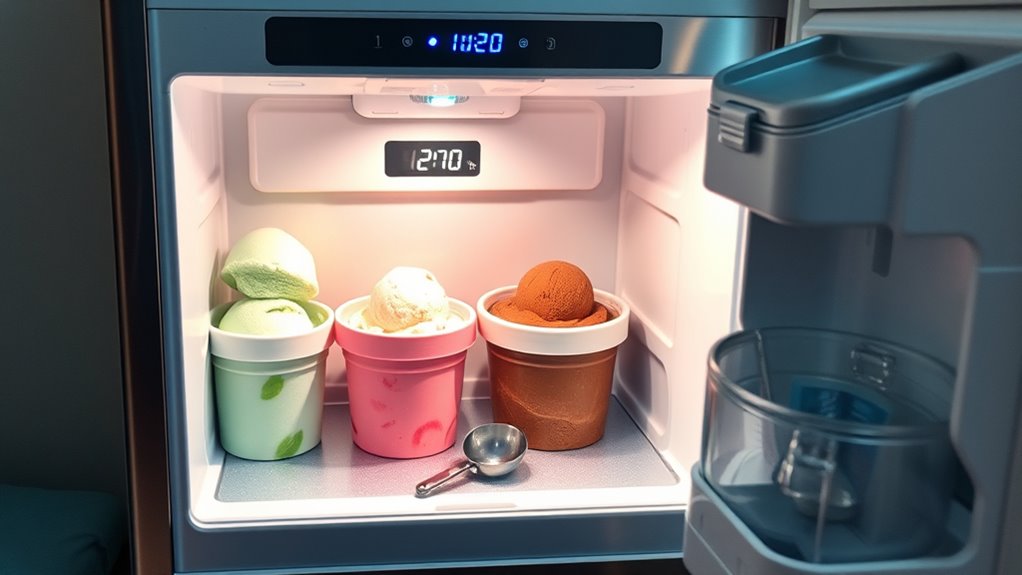
Keeping your ice cream in the right spot is just the start; monitoring your freezer’s temperature is key for maintaining that perfect texture. You need to guarantee your freezer stays at or below 0°F (-18°C) to preserve that delightful frozen state.
Regularly check the temperature with a thermometer to catch any fluctuations, as soft or soupy ice cream can’t say enough about a malfunctioning freezer. A well-stocked freezer helps maintain consistent temperatures, but don’t overload it; that can block airflow and lead to uneven freezing.
Periodically checking your ice cream’s consistency will give you insight into your freezer’s performance. If it’s not holding up, it might be time to adjust your storage strategy.
Exploring Alternatives for Ice Cream Storage
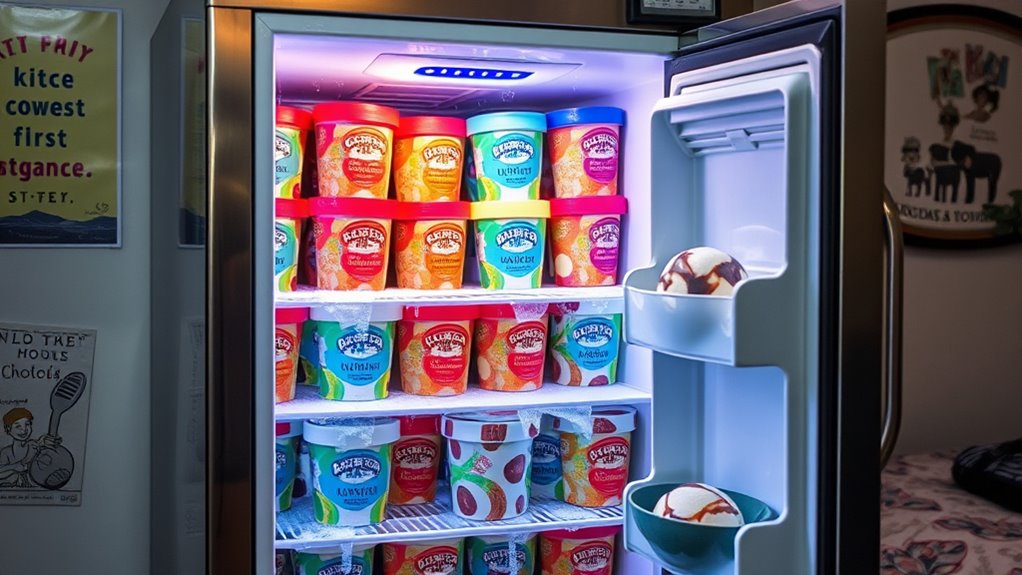
If you’re struggling to store ice cream in a standard dorm fridge, it’s time to explore better alternatives.
Standard dorm fridges just can’t maintain the cold temperatures needed for ice cream. Here are some options to evaluate for better storage:
- Dedicated Ice Cream Freezer: Invest in one that can maintain temperatures at or below 0°F (-18°C).
- Airtight Containers: Use these to minimize air exposure and prevent freezer burn.
- Compressor Mini Fridge: If a mini fridge is your only choice, opt for a compressor model for better cooling.
- Regular Monitoring: Check the consistency of your ice cream; soft or slushy means it’s not cold enough.
With these alternatives, you can enjoy your ice cream without worry!
Frequently Asked Questions
Can a Mini Fridge Keep Ice Cream Frozen?
A mini fridge might struggle to keep your ice cream frozen. Most models, especially thermoelectric ones, can’t reach the necessary temperatures of 0°F (-18°C) or lower.
Even if you have a compressor fridge, it mightn’t maintain those freezing levels consistently. If you want perfectly frozen ice cream, consider investing in a small standalone freezer designed for that purpose.
Monitoring the temperature is essential, as incorrect settings can lead to soft, soupy treats.
Does Ice Cream Go Bad if Left in the Fridge?
Imagine biting into your favorite ice cream only to find it’s become a grainy mess.
If you leave ice cream in the fridge, it won’t technically “go bad,” but it’ll lose its delightful texture and flavor within hours or days.
Ice crystals form, ruining the creamy experience you love.
To keep your ice cream enjoyable, always store it in a freezer and use airtight containers to lock in that delicious taste.
Can You Keep Dairy in a Mini Fridge?
Yes, you can keep dairy in a mini fridge, but it’s important to guarantee the fridge can maintain the right temperature.
Set it to the coldest setting and check it with a thermometer regularly. Use airtight containers to prevent spoilage and freezer burn.
If your mini fridge has a reliable compressor, you’ll have better luck preserving your dairy products.
Just remember, consistent cold temperatures are key to keeping them fresh.
How to Store Ice Cream in a Single Door Fridge?
Think of ice cream as a delicate treasure you want to protect.
To store it properly in a single door fridge, set the freezer to its lowest temperature, ideally around -18°F.
Use airtight containers instead of cardboard to keep it fresh and prevent freezer burn.
Place your ice cream at the back of the freezer, away from fluctuating temperatures, and limit how often you open the door to maintain that perfect chill.
Conclusion
To summarize, storing ice cream in a dorm fridge might seem tricky, but with the right strategies, you can enjoy your favorite treat without worry. By understanding your mini-fridge’s limitations and keeping an eye on temperature, you’ll guarantee your ice cream stays creamy and delicious. Isn’t it worth a little extra effort to enjoy a perfectly scooped bowl of ice cream after a long day of classes? Embrace these tips and savor every bite!
